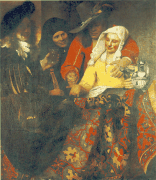The Procuress
Dresden, Gemaldegalerie
143x130 1656
 (Large)
(Large)
Here we see Vermeer's style changing from Biblical and mythological
scenes to interior, genre paintings. The richly colored rug and
strewn coat provide the stage behind which the principle characters
are lined up to show their message. The composition is recognizable
from Vermeer's mature period, the viewer firmly separated from
the subjects, but there is little spatial quality, and
the the pitcher at the right seems to be about to fall over.
These brothel scenes, or Bordeeltje, were popular at the time
as a response to an increasingly prudish, puritan ethos.
The original derivation is a depiction
of the Prodigal Son, frittering away his money on whores, with the
contrast being the mercy and forgiveness of the loving father. The
fascinating theme of the brothel quickly evolved to be an independent genre.
A painting by
Dirck van Baburen, The Procuress hung in
the house of Vermeer's mother-in-law, and may have been the inspiration
for the subject, if not the composition. The Baburen appears in
the background of two later Vermeer's: The Concert
and Lady Seated at the Virginals.
The theme is that the evils of money and alcohol have combined. In addition
to the woman's bright yellow jacket, the wine has brought color to the her
cheeks. She nestles contentedly into the arm of the red-jacketed soldier
who is offering a coin, but also seems to be ready to flip the coin or to
hide it in his hand. The woman, the soldier, and the brilliant rug are
center-stage, but also, at the right, are two dark, ambiguous figures,
with the dark draped jacket below. Lubricating the transaction is the
androgenous onlooker in black, the procuress.
The figure at the left has the self-conciousness of a self-portrait.
If so, this the only picture of Vermeer in existence.
This grinning figure is perhaps toasting with us, ready to celebrate the fun.
Brought to you by
BallAndClaw.com.
 (Large)
(Large)